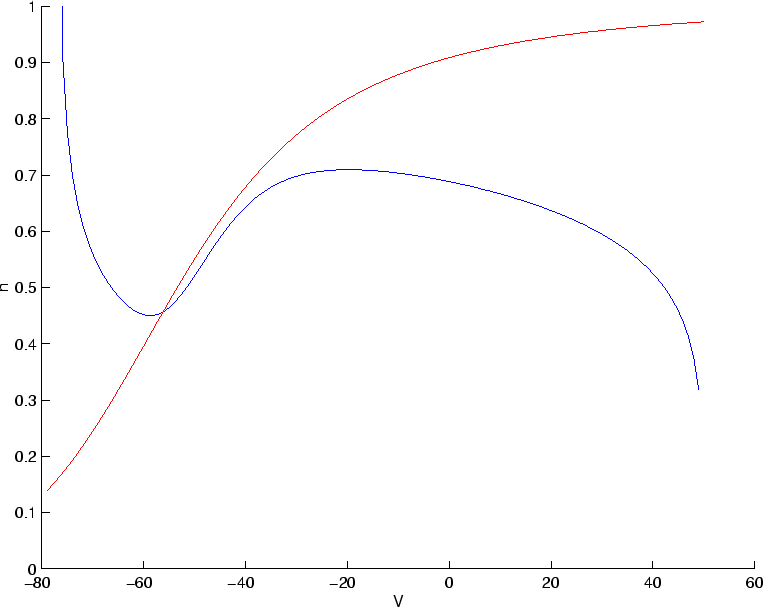
It can be shown numerically that when equations (2) and (3)
exhibit periodically firing action potentials,

For fast-slow systems, a useful procedure for understanding the dynamics
is to consider the nullclines. The V-nullcline is the set in
![]() space for which
space for which
![]() , while the n-nullcline is
the set in
, while the n-nullcline is
the set in ![]() space for which
space for which
![]() . It is messy to
obtain analytical expressions for the nullclines of equations (2)
and (3), but they can be computed numerically using the fzero
command in Matlab which finds solutions
. It is messy to
obtain analytical expressions for the nullclines of equations (2)
and (3), but they can be computed numerically using the fzero
command in Matlab which finds solutions ![]() of the equation
of the equation ![]() .
To do this, download the following three programs. First, nullclines.m:
.
To do this, download the following three programs. First, nullclines.m:
global vna vk vl gna gk gl c I v
vna=50;
vk=-77;
vl=-54.4;
gna=120;
gk=36;
gl=.3;
c=1;
I = 20;
for i=1:130
v = -80 + i + 0.01;
vv(i) = v;
nullv(i) = fzero('rhsV',0.5);
nulln(i) = fzero('rhsn',0.5);
end
figure(2)
hold on;
plot(vv,nullv,'b');
plot(vv,nulln,'r');
axis([-80 60 0 1]);
xlabel('V');
ylabel('n');
Next, rhsV.m, which is the righthand side of equation (2):
function r = rhsV(n)
global vna vk vl gna gk gl c I v
r = (I - gna*(m_inf(v))^3*(0.8-n)*(v-vna) - gk*n^4*(v-vk)-gl*(v-vl))/c;
function r = rhsn(n)
global vna vk vl gna gk gl c I v
r = an(v)*(1-n) - bn(v)*n;
Note that in these programs, the membrane voltage (the Matlab variable ``v'') is treated as a global variable. This is because the functions that fzero uses need to be functions of a single, scalar variable. After downloading these programs, type ``nullclines'' at the Matlab prompt. You might get a few messages saying that Matlab was unable to find some zeros - this is OK. One obtains the following figure:
 |
Note that the point at which the nullclines intersect corresponds to a
``fixed point'' of equations (2) and (3). At this
point,
![]() .
.
Using the functions rhsV.m and rhsn.m, verify that